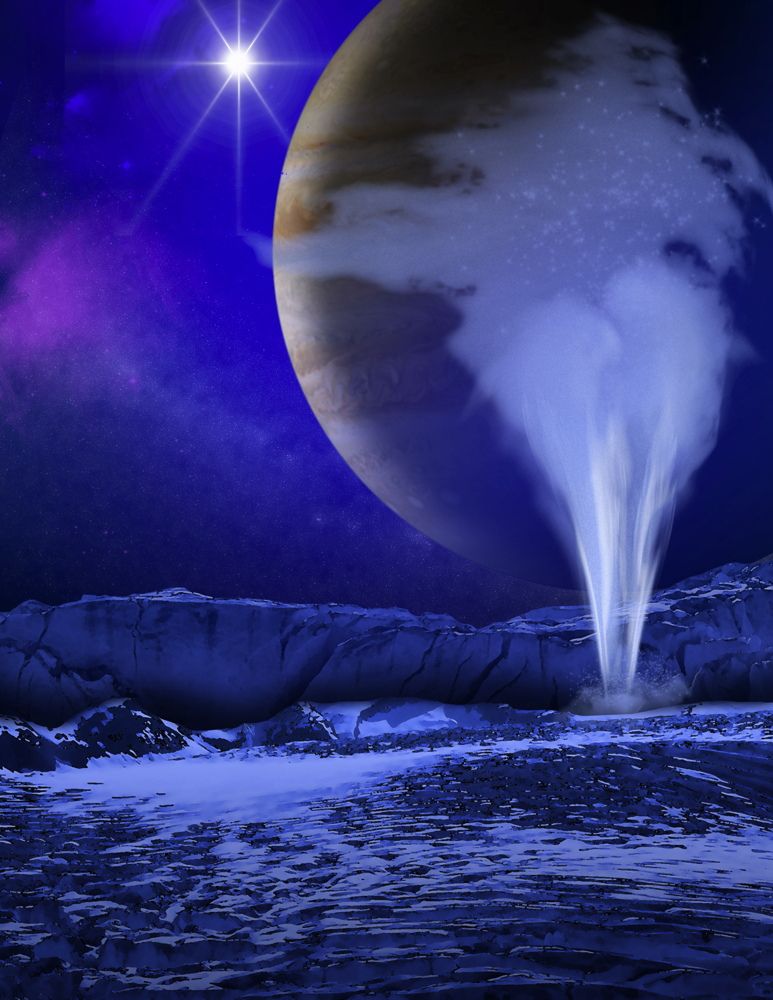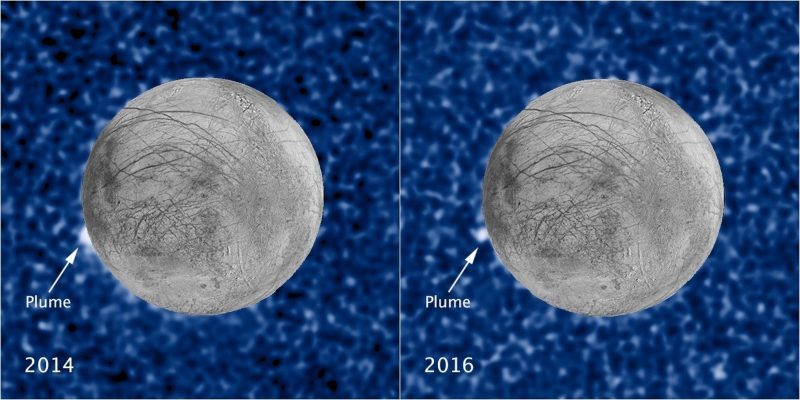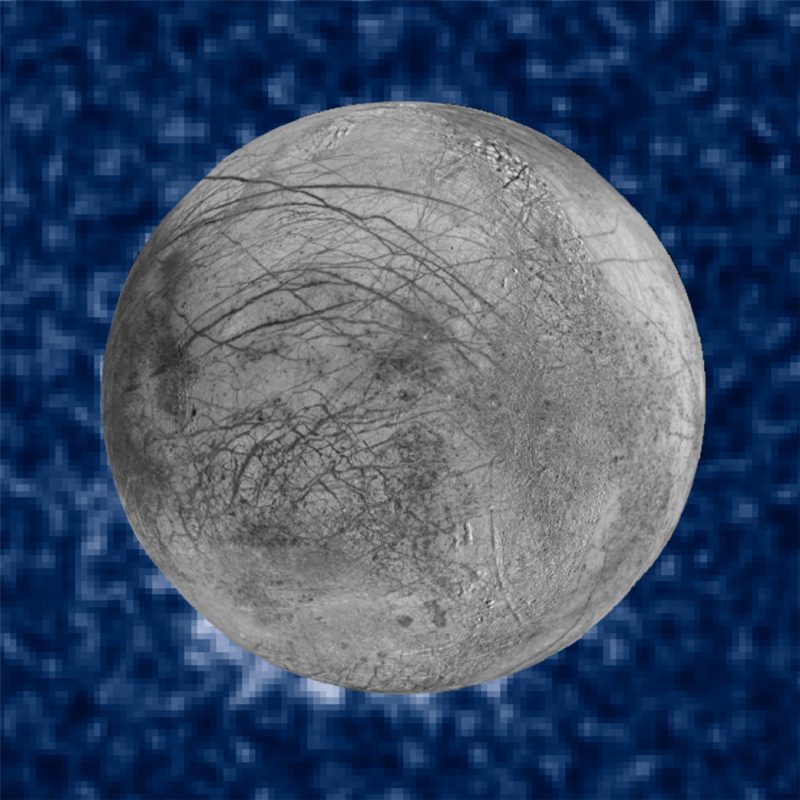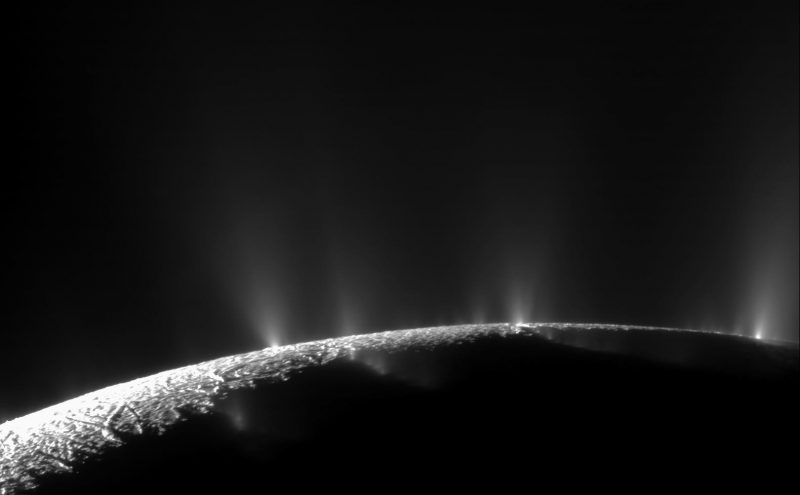
Jupiter’s large moon Europa is one of the most intriguing places in the solar system, an ocean world that might support life of some kind. As well as a subsurface ocean, it might also share another characteristic of Saturn’s moon Enceladus: geyser-like water vapor plumes bursting through its icy surface. The evidence for geysers on Europa has been tentative up to now, but this month (November 18, 2019) scientists said they’ve found what might be new confirmation: they reported the direct detection of water vapor above the moon’s surface.
The peer-reviewed findings, from scientists at NASA’s Goddard Space Flight Center, were published in the journal Nature Astronomy on November 18, 2019.
Like Enceladus, Europa has a deep ocean below the outer ice crust. On Enceladus, water percolates up to the surface from the ocean below, erupting into space through cracks in the ice as water vapor. It has long been thought that the same thing could be happening on Europa, but the evidence hasn’t been as solid yet, with hints of activity seen by the Hubble Space Telescope (HST).
According to NASA scientist Lucas Paganini:
Essential chemical elements (carbon, hydrogen, oxygen, nitrogen, phosphorus, and sulfur) and sources of energy, two of three requirements for life, are found all over the solar system. But the third — liquid water — is somewhat hard to find beyond Earth. While scientists have not yet detected liquid water directly, we’ve found the next best thing: water in vapor form.
EarthSky 2020 lunar calendars are available! They make great gifts. Order now. Going fast!



So how much water vapor was detected?
According to Paganini, about 5,202 pounds (2,360 kilograms) per second, enough to fill an Olympic-size swimming pool within minutes.
But like earlier observations have suggested, the outbursts of water vapor appear to be infrequent, unlike those on Enceladus, which erupt on a regular basis. Paganini said:
For me, the interesting thing about this work is not only the first direct detection of water above Europa, but also the lack thereof within the limits of our detection method.
The signal of water vapor is distinct but faint, and was only seen once in 17 nights of observations in 2016 and 2017. That suggests that Europa’s plumes are much more sporadic than those on Enceladus. The science team detected the water molecules on Europa’s leading hemisphere, the side of the moon that’s always facing in the direction of the moon’s orbit around Jupiter. Like Earth’s moon, Europa is gravitationally locked to its planet, so the leading hemisphere always faces the direction of the orbit, while the trailing hemisphere always faces in the opposite direction. The detection was made using a spectrograph at the W. M. Keck Observatory on Mauna Kea in Hawaii. The spectrograph measures the chemical composition of planetary atmospheres through the infrared light they emit or absorb. From the paper:
Previous investigations proved the existence of local density enhancements in Europa’s atmosphere, advancing the idea of a possible origination from water plumes. These measurement strategies, however, were sensitive either to total absorption or atomic emissions, which limited the ability to assess the water content. Here we present direct searches for water vapor on Europa spanning dates from February 2016 to May 2017 with the Keck Observatory. Our global survey at infrared wavelengths resulted in non-detections on 16 out of 17 dates, with upper limits below the water abundances inferred from previous estimates. On one date (26 April 2016) we measured 2,095 ± 658 tonnes of water vapor at Europa’s leading hemisphere. We suggest that the outgassing of water vapor on Europa occurs at lower levels than previously estimated, with only rare localized events of stronger activity.
Some of the tentative evidence for Europa’s plumes came from studying data sent back by the Galileo spacecraft. The disturbances in Jupiter’s magnetic field that provided clues about the subsurface ocean also hinted at possible plumes, according to researchers in 2018. In 2013, the HST had detected the chemical elements hydrogen and oxygen in plume-like configurations in Europa’s extremely tenuous atmosphere. Then, in 2016, Hubble imaged “finger-like projections” in silhouette while Europa passed in front of Jupiter. All of these findings were tantalizing, but still tentative. But now the first detection of water vapor itself is additional evidence for the plumes. As Lorenz Roth, an astronomer and physicist at the KTH Royal Institute of Technology, said:
This first direct identification of water vapor on Europa is a critical confirmation of our original detections of atomic species, and it highlights the apparent sparsity of large plumes on this icy world.
One problem that Paganini and his team needed to address, however, was that water in Earth’s atmosphere can distort the readings of water vapor on distant worlds taken by ground-based telescopes like Keck. To compensate, complex mathematical and computer modeling was used to simulate the conditions of Earth’s atmosphere so they could differentiate Earth’s atmospheric water from Europa’s in the data. According to Avi Mandell, a Goddard planetary scientist:
We performed diligent safety checks to remove possible contaminants in ground-based observations. But, eventually, we’ll have to get closer to Europa to see what’s really going on.

Not all researchers, however, are convinced that the new findings prove the existence of the plumes, and emphasize how they show that the geyser activity is probably lower than had been anticipated. Astronomer Phil Plait wrote about this in an addendum to his Nov. 19, 2019, article on SYFY about the news:
Correction, and it’s a big one: When I wrote this, I thought the conclusions based on the observations were much more solid than they were reported in a NASA press release. But after being alerted by a couple of astronomers, and looking things over again, I see that the idea that a plume of water from a geyser is not “confirmed” as I originally wrote, but more like “maybe.” The detection by itself was marginally statistically significant, but was part of 16 other observations that showed nothing. I was thinking about the single observation taken alone, but when placed in context of the other observations the statistical significance drops. That means the likelihood of this observation being real – that is, that the light from a plume of water was definitely seen – is lower than I originally stated.
So at this point, it may be safer to say that the new observations add to the evidence for water vapor geysers on Europa, but are still not 100% conclusive. This does not take away from the abundant evidence for the subsurface ocean, it only addresses how much of that water may actually make it to the surface and erupt as vapor into space. Hopefully NASA’s upcoming Europa Clipper mission – due to launch in the mid-2020s – will be able to finally settle the question of whether the geysers are real or not, and how frequent they are, if other observations don’t beforehand. It could even sample them directly, just like Cassini did at Enceladus.
Bottom line: Scientists have found new evidence for water vapor geysers on Europa, although whether they have actually been proven now is a matter of debate.
Source: A measurement of water vapour amid a largely quiescent environment on Europa











